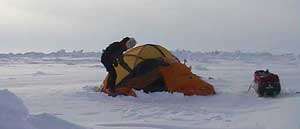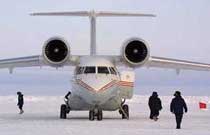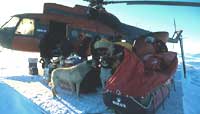 Sunday 21 April (day 56) : Searching for a landing strip…
Sunday 21 April (day 56) : Searching for a landing strip…
For
three days now, Alain and Dixie have changed course, having no other
alternative since the announcement that no recovery from the North
Pole would be possible after mid-May. They are therefore heading
northwest and moving towards Cape Arktichewski and Stredny Island
(see our map of the return leg) from which the Antonov 2 will be
leaving to look for them on the ice. 
What
are the unknowns and risks of this recovery?
1.
The Russian single-engine aircraft Antonov 2 has a range of only
1,200 km, when loaded to the full (with fuel barrels) and the
additional weight to be carried is of no great importance. As far
as this last point is concerned, no problem: the sledges weigh no
more than a hundred kilos or so and the two men have lost a lot
of weight, especially Alain.
But they are too far from Cape Arktichewski; indeed, the men are
still 820km from Stredny-Arktichewski at this time and they obviously
cannot make the sufficient mileage that would avoid a fuel deposit
having to be made, in view of the conditions of the ground encountered
these last days (worse than ever, they say). A small fuel deposit
will therefore have to be made on the ice somewhere between the
place of take-off and the place where the expedition will be on
that particular day. This deposit will not be made on terra firma
(which would have been the best solution) but on pack ice, which,
as has been seen, is worse than unpredictable this year.
2.
The Antonov 2 must have a 300m-length of ice to be able to set down
its skis;
the landing surface must in addition be as naturally flat as possible
and the ice must be at least 60cm thick. However, since they changed
course, Alain and Dixie have been noticing that the ice too is getting
thinner - today, this evening, they are camping on new ice that
is 30cm thick. Too thin for any possible landing.
3.
Since they left Cape Anisiy, on 25 February, they have not yet come
across ground that would be suitable for an Antonov 2 landing:
we must hope that they find some, and of course pretty soon.
We are
of course talking here about the optimal conditions for a pick up;
but all specialists also know that the Russian aviators who work
the Arctic pack ice are superb pilots who, in an emergency, are
capable of amazing feats.
4.
When is all this going to happen ?
As soon as Cerpolex has the available machines. Because, for any
operation of this kind, one needs the presence on the ground (here,
on Stredny Island in fact) of an MI 8 helicopter which, on stand-by,
could provide any possible support and assistance.
During
the first days of this week, Cerpolex was still occupied with a
major operation for the National Scientific Foundation (NSF), which
is recovering probes placed on sea-beds at a depth of more than
4,000 metres (see this programme here). It is therefore only with
effect from Wednesday or Thursday that the men of Compaq Pole II
could be recovered.
For
two days, the men have been virtually going round in circles with
a drift that is driving them crazy, pushing them at times to the
East and at times to the West, and the mercury has again dropped
to -30° C, the weather is set fair, but of course their hearts
are no longer in it... And they still have to find a landing strip…
 Saturday 20 April (day 55) : No contact today
Saturday 20 April (day 55) : No contact today
 Friday 19 April (day 54) : They continue walking while HQ prepares
the "Recovery" operation…
Friday 19 April (day 54) : They continue walking while HQ prepares
the "Recovery" operation…
Due
to the preparation of the operation for recovering Alain and Dixie,
we are unable to provide a complete analysis of the situation today;
we will write it during the weekend.
Just
some info therefore on the day's satellite (Iridium)
slot; on top physical form and maintaining good morale despite having
to give up, the two men continue to walk despite the odds (they
know that they have to get as close as they can to Cape Arktichewski)
in an atmosphere from another world (pack ice more chaotic than
ever, gigantic blocks of ice as tall as cathedrals, etc.) and therefore
have to move towards the place from which the Antonov 2 should be
leaving, all being well, to pick them up next week...
|
We
would like to express our most appreciative thanks to Their
Royal Highnesses, Prince Philippe and Princess Mathilde, for
the close interest they are showing in our expedition and
for their message of encouragement to our two polar adventurers.
|
 |
To
follow next week, the promised case file on the hundred-year-old
controversy between Peary and Cook. Which of the two of them
was the first to reach the North Pole?
Did one of them in fact never reach it?
 Thursday 18 April (day 53) : Team has to withdraw. The final part
of the expedition will not be any calmer…
Thursday 18 April (day 53) : Team has to withdraw. The final part
of the expedition will not be any calmer…
The
men are of course under the blow of the information broadcast by
First Air Canada: no recovery from the North Pole after 15-20 May.
This means that Alain and Dixie have to make some important decisions
about how they are going to get themselves picked up by the logistics
of Cerpolex.
With
the situation changing hour by hour - (where are they going to get
themselves picked up? By what type of machine? Will they be able
to get close enough to make the operation possible? Where will take-off
occur? When are they going to be picked up? Will they find a suitable
terrain for the landing? Etc, Etc), we are still not in a position
of being able to draw up a precise diagram of the definitive turn
of events for this final part of the adventure.
But
one thing is certain: the HQ team will do all that it can to enable
the many visitors to the website to follow this important recovery
operation as fully as possible, day by day, hour by hour, and virtually
live if necessary.
That
said, the men have managed, by dint of their courage and tenacity,
to make up almost all of yesterday's lost ground. Furthermore, the
mercury has shot back up and the current -20°C has changed their
lives, they say. Which tells us that Alain and Dixie are on form
and that they are therefore ready to give what remains of their
strength to ensure that the recovery operation proceeds in the best
possible conditions.
 Wednesday 17 April (day 52) : Two bits of bad news
Wednesday 17 April (day 52) : Two bits of bad news
 Let's
start with the first one: Alain and Dixie have not moved
from their tent today. White out, zero visibility and wind from
the Southwest all day blowing between 35 and 50 kph. Assessment:
20 km of drift to the East pushing the expedition by the same token
a few kilometres to the South. Yesterday, they were 1,164 km from
the Pole, this evening, the GPS counter reads 1,172 km... Not much
to rejoice about.
Let's
start with the first one: Alain and Dixie have not moved
from their tent today. White out, zero visibility and wind from
the Southwest all day blowing between 35 and 50 kph. Assessment:
20 km of drift to the East pushing the expedition by the same token
a few kilometres to the South. Yesterday, they were 1,164 km from
the Pole, this evening, the GPS counter reads 1,172 km... Not much
to rejoice about.
Now
the second one : Canadian company First Air (which picks
up adventuring explorers at the North Pole if they stop their journey
there) has just confirmed some news that we have been suspecting
we might hear for some weeks now: this year, unlike other years,
its Twin Otters based at Resolute Bay will not be able to pick up
adventurers at the North Pole after mid-May, whereas usually the
pick-up happens up to the beginning of June (sometimes up to mid-June).
Why? Because, say First Air Canada, this spring, things are different.
On the one hand, the weather is particularly lousy this year (-44°C
around Ward Hunt in April, which is what the expeditions that have
chosen this route have been experiencing in recent days, which is
totally unprecedented); on the other hand, the previous winter was
particularly warm, which had the direct consequence of breaking
up and fragmenting the Arctic ice floe more than in the past. Landing
after mid-May could prove far too dangerous; so no expeditions will
be picked up after that period. 
This is bad news for the expeditions which are trying to reach the
North Pole in general, and for Compaq Pole II in particular.
For those who are attempting the journey from the Ward Hunt side,
it is hard to see how they could complete the remaining 500 or 600
km, when they are moving at an average of 3 or 4 km per day, and
they only have 30 days to reach the Pole. They would have to speed
up to at least 20 km/day to succeed. Singapore's Khoo Swee Chiow
(see our "Other expeditions / Live"section) is moving
fast, but he is travelling light and is being re-supplied on several
occasions. The other expeditions like the three British women or
the Sjogrens, for example, have chosen to go it alone, and reaching
an average of 20 km per day with the weight they are dragging and
the terrain they are crossing is in the realms of Utopia. This is
an opportunity to realise the difference between the effort required
of expeditions who are travelling entirely unassisted, and those
who are being re-supplied en route.

For Compaq Pole II, the situation is much more worrying. Because
the men are having to reconsider the goal of their expedition yet
again. After having dropped the idea of completing the crossing
just a few days ago, they had defined a new objective, stopping
at the Pole which they thought they could reach by the beginning
of June. Which would have been possible if the conditions on the
ground had improved, and in recent days, that had been the case.
But the news from First Air came like a bolt from the blue, and
a new strategy is now required. Having been informed yesterday by
HQ, Hubert and Dansercoer said they wanted time to think - after
all, are we not living in a world where nothing is urgent?
Perhaps, but the factors that the two polar explorers have to take
into account will remain inevitable. One: it is impossible for them
(or virtually impossible) to reach the North Pole before 15-20 May.
Two: the men only have 47 days' food supplies in their baggage. Three: as First Air will not pick up anybody beyond the North Pole,
it will be French TO Cerpolex that will have to pick up the expedition.
Four: Dixie and Alain want to continue heading north to go as far
as possible, and it is hard to see them doing an about-turn towards
Cape Anisiy, especially when the drift will be pushing them in the
opposite direction to the way they would have to go. Five: Cerpolex,
which sets up the Barneo tourist base near the North Pole each year
(see our account last Friday), it usually closes it again in the
first few days of May. That does not leave much time. Six: obviously
the Cerpolex management will leave it as late as possible - in other
words the end of April or early May depending on the programme of
their clientele - before picking up Alain and Dixie. That is so
that the two men can get as close to Barneo as possible during those
two weeks, or any other point of departure of an aircraft or helicopter
that is prepared to take them. But where will Alain and Dixie be
at that time?
Three: as First Air will not pick up anybody beyond the North Pole,
it will be French TO Cerpolex that will have to pick up the expedition.
Four: Dixie and Alain want to continue heading north to go as far
as possible, and it is hard to see them doing an about-turn towards
Cape Anisiy, especially when the drift will be pushing them in the
opposite direction to the way they would have to go. Five: Cerpolex,
which sets up the Barneo tourist base near the North Pole each year
(see our account last Friday), it usually closes it again in the
first few days of May. That does not leave much time. Six: obviously
the Cerpolex management will leave it as late as possible - in other
words the end of April or early May depending on the programme of
their clientele - before picking up Alain and Dixie. That is so
that the two men can get as close to Barneo as possible during those
two weeks, or any other point of departure of an aircraft or helicopter
that is prepared to take them. But where will Alain and Dixie be
at that time?  At
their present rate of progress, and even if they pull out all the
stops, as they say, will they not be too far away from any airport
for a recovery operation to be organised conveniently? It will have
to be an MI 8 helicopter or a small Antonov (Twin Otter type plane),
and those aircraft, which are the only ones that could pick up the
two men, only have a range of 1200 km when they are full to bursting
point. And it should not be overlooked that they will be making
an outward and return journey. If the pick-up is beyond that distance
away, it is a quite different operation that needs to be set up,
with interim camps being set up, fuel dumps on the ice and of course,
the risk of the drums disappearing into the a crevasse that suddenly
appears, or not being able to land to refuel where the drums have
been dropped, due to particularly broken ice, which is changing
the terrain from day to day in the Arctic this year.
At
their present rate of progress, and even if they pull out all the
stops, as they say, will they not be too far away from any airport
for a recovery operation to be organised conveniently? It will have
to be an MI 8 helicopter or a small Antonov (Twin Otter type plane),
and those aircraft, which are the only ones that could pick up the
two men, only have a range of 1200 km when they are full to bursting
point. And it should not be overlooked that they will be making
an outward and return journey. If the pick-up is beyond that distance
away, it is a quite different operation that needs to be set up,
with interim camps being set up, fuel dumps on the ice and of course,
the risk of the drums disappearing into the a crevasse that suddenly
appears, or not being able to land to refuel where the drums have
been dropped, due to particularly broken ice, which is changing
the terrain from day to day in the Arctic this year.
In other words, for the Compaq Pole II expedition, the cold sweats
are far from over...
 Tuesday 16 April (day 51) : 3 hours of sails, but leads to cross
once again…
Tuesday 16 April (day 51) : 3 hours of sails, but leads to cross
once again…
For
the first time since the beginning of the expedition, Alain and
Dixie have been able use their sails, for a period of three hours.
On a terrain which is indeed getting flatter as announced in our
earlier reports,
But,
as this adventure definitely has some kind of curse on it, they
again had to cross two leads, spend one and a half hours untangling
the lines of one of the power kites which had been wedged in a pressure
ridge and negotiate a strong drift that was pushing them, this time,
eastwards. The day's assessment: 7 effective kilometres to the North.
-40°C
yesterday and -23°C today, a temperature finally more lenient
therefore, 7 hours of daily work, excellent morale, and a physical
fitness that has returned from afar...
The
6th episode of the Nansen's Exploits
 We
continue today the fascinating story of Nansen which happened exactly
107 years ago to the day.
We
continue today the fascinating story of Nansen which happened exactly
107 years ago to the day.
On 14
April 1895, Nansen and his companion Johansen decided to give up
their idea of getting to the North Pole and from now go back to
Siberia, travelling over François Joseph Land (Siberia).
 Monday 15 April (day 50) : No sat contact today
Monday 15 April (day 50) : No sat contact today
While
waiting for the satellite link of the day
discover how the adventurer-explorers find
their way in those inhospitable polar regions.
For
a more global view and greater facility,
see our comparative table of expeditions
that are still under way, with direct access
to their websites and our follow-up pages.
To
display the previous follow up pages, click on the related week
below the button "Dispatches"



 Let's
start with the first one: Alain and Dixie have not moved
from their tent today. White out, zero visibility and wind from
the Southwest all day blowing between 35 and 50 kph. Assessment:
20 km of drift to the East pushing the expedition by the same token
a few kilometres to the South. Yesterday, they were 1,164 km from
the Pole, this evening, the GPS counter reads 1,172 km... Not much
to rejoice about.
Let's
start with the first one: Alain and Dixie have not moved
from their tent today. White out, zero visibility and wind from
the Southwest all day blowing between 35 and 50 kph. Assessment:
20 km of drift to the East pushing the expedition by the same token
a few kilometres to the South. Yesterday, they were 1,164 km from
the Pole, this evening, the GPS counter reads 1,172 km... Not much
to rejoice about.

 Three: as First Air will not pick up anybody beyond the North Pole,
it will be French TO Cerpolex that will have to pick up the expedition.
Four: Dixie and Alain want to continue heading north to go as far
as possible, and it is hard to see them doing an about-turn towards
Cape Anisiy, especially when the drift will be pushing them in the
opposite direction to the way they would have to go. Five: Cerpolex,
which sets up the Barneo tourist base near the North Pole each year
(see our account last Friday), it usually closes it again in the
first few days of May. That does not leave much time. Six: obviously
the Cerpolex management will leave it as late as possible - in other
words the end of April or early May depending on the programme of
their clientele - before picking up Alain and Dixie. That is so
that the two men can get as close to Barneo as possible during those
two weeks, or any other point of departure of an aircraft or helicopter
that is prepared to take them. But where will Alain and Dixie be
at that time?
Three: as First Air will not pick up anybody beyond the North Pole,
it will be French TO Cerpolex that will have to pick up the expedition.
Four: Dixie and Alain want to continue heading north to go as far
as possible, and it is hard to see them doing an about-turn towards
Cape Anisiy, especially when the drift will be pushing them in the
opposite direction to the way they would have to go. Five: Cerpolex,
which sets up the Barneo tourist base near the North Pole each year
(see our account last Friday), it usually closes it again in the
first few days of May. That does not leave much time. Six: obviously
the Cerpolex management will leave it as late as possible - in other
words the end of April or early May depending on the programme of
their clientele - before picking up Alain and Dixie. That is so
that the two men can get as close to Barneo as possible during those
two weeks, or any other point of departure of an aircraft or helicopter
that is prepared to take them. But where will Alain and Dixie be
at that time?  At
their present rate of progress, and even if they pull out all the
stops, as they say, will they not be too far away from any airport
for a recovery operation to be organised conveniently? It will have
to be an MI 8 helicopter or a small Antonov (Twin Otter type plane),
and those aircraft, which are the only ones that could pick up the
two men, only have a range of 1200 km when they are full to bursting
point. And it should not be overlooked that they will be making
an outward and return journey. If the pick-up is beyond that distance
away, it is a quite different operation that needs to be set up,
with interim camps being set up, fuel dumps on the ice and of course,
the risk of the drums disappearing into the a crevasse that suddenly
appears, or not being able to land to refuel where the drums have
been dropped, due to particularly broken ice, which is changing
the terrain from day to day in the Arctic this year.
At
their present rate of progress, and even if they pull out all the
stops, as they say, will they not be too far away from any airport
for a recovery operation to be organised conveniently? It will have
to be an MI 8 helicopter or a small Antonov (Twin Otter type plane),
and those aircraft, which are the only ones that could pick up the
two men, only have a range of 1200 km when they are full to bursting
point. And it should not be overlooked that they will be making
an outward and return journey. If the pick-up is beyond that distance
away, it is a quite different operation that needs to be set up,
with interim camps being set up, fuel dumps on the ice and of course,
the risk of the drums disappearing into the a crevasse that suddenly
appears, or not being able to land to refuel where the drums have
been dropped, due to particularly broken ice, which is changing
the terrain from day to day in the Arctic this year. 